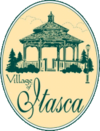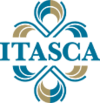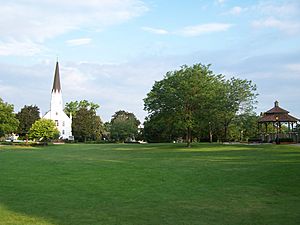Itasca, Illinois facts for kids
Quick facts for kids
Itasca, Illinois
|
|||||
|---|---|---|---|---|---|
|
Village
|
|||||
| Village of Itasca | |||||
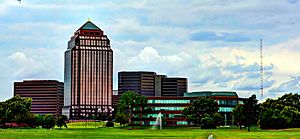 |
|||||
|
|||||
| Motto(s):
Committed to Our Future, Inspired by Our Past
|
|||||
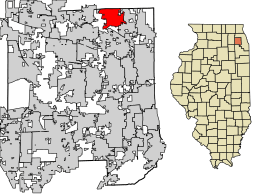
Location of Itasca in DuPage County, Illinois.
|
|||||
| Country | United States | ||||
| State | Illinois | ||||
| County | DuPage | ||||
| Settled | 1841 | ||||
| Incorporated | 1890 | ||||
| Government | |||||
| • Type | Village Board of Trustees | ||||
| Area | |||||
| • Total | 5.14 sq mi (13.32 km2) | ||||
| • Land | 5.02 sq mi (13.01 km2) | ||||
| • Water | 0.12 sq mi (0.32 km2) | ||||
| Population
(2020)
|
|||||
| • Total | 9,543 | ||||
| • Density | 1,900.24/sq mi (733.72/km2) | ||||
| Time zone | UTC-6 ((CST)) | ||||
| • Summer (DST) | UTC-5 ((CDT)) | ||||
| ZIP code(s) |
60143
|
||||
| Area code(s) | 630 | ||||
| FIPS code | 17-37907 | ||||
Itasca (pronounced eye-TASS-kuh) is a village in DuPage County, Illinois, United States. In 2020, about 9,543 people lived there. Itasca is located about 25 miles northwest of downtown Chicago. It is also close to O'Hare International Airport. Major highways and train lines are nearby.
Itasca has a country club and a resort. It also borders the famous Medinah golf course. BusinessWeek magazine once called Itasca the Best Affordable Suburb in Illinois.
Contents
History of Itasca
Early Settlement and Growth
Itasca was first settled in 1841 by a doctor named Elijah Smith. He came from Boston looking for a good place to practice medicine and farm. President John Tyler signed the land title for Smith in 1843. This land is now a central part of Itasca.
A post office was set up in 1846. It had different names before being called Itasca. The name Itasca comes from Lake Itasca, which is the source of the Mississippi River. The first school was built in the 1860s. It was a small, one-room wooden building.
In 1873, Elijah Smith divided 80 acres of his land into smaller lots. The Chicago and Pacific Railroad built a line through the area. Smith helped by giving land for the tracks. He also gave $400 to help build a train station. This helped the settlement grow.
The Chicago and Pacific Railroad later went out of business. In 1880, the Chicago, Milwaukee, St. Paul and Pacific Railroad took over the line.
Becoming a Village
The people of Itasca decided to become an official village in 1890. A. G. Chessman was elected as the first Village President. This is like being the mayor of the village. Irving Park Road, a main street, was originally called the Chicago and Elgin Road. Its name was changed to Elgin Avenue in 1891.
The 1900s and Modern Itasca
In 1985, Itasca created a Historical Commission. This group works to keep the village's old homes and buildings looking nice. They want to save the history and unique look of Itasca. In 1987, the village passed a law to protect historic places.
The Itasca Historical District covers a specific area of the village. It includes many old and important buildings.
The Spire is a famous landmark in Itasca. It sits on top of what used to be the Lutheran Church of St. Luke. This church was built in 1907. For many years, church services were held in German. English services started being held twice a month in 1926.
Before 1916, Itasca did not have a bank. A man named Herman H. Franzen would take money deposits to a bank in a nearby town by train. In 1916, two banks opened in Itasca. The Franzen family banks did well even during the tough times of the Great Depression.
Telephone service came to Itasca in 1899. Electricity was first installed in some homes in 1923. The Itasca Country Club opened in 1925.
Itasca was a quiet, rural village until the 1940s. Then, it started to become a "suburb." This means it became a residential area near a big city. More people moved in, and many started traveling daily to work in Chicago. By 1982, the population grew to 7,192 people.
As the village grew, new services were needed. Departments for public works, water, police, and fire were created. A park district and a village library were also formed.
High school students from Itasca used to go to schools in other towns. In 1953, a high school district was formed. Lake Park High School opened in 1956. Students from Itasca and nearby towns attend this school.
Modern industries started coming to Itasca in 1961. An industrial park was built on the western edge of the village. Big companies like Continental Can and FMC moved in. Another industrial park was created in 1970, attracting even more businesses.
A Holiday Inn hotel was built in Itasca. It was special because it was one of the first hotels in the nation built using modular construction. This means parts of the building were made elsewhere and then put together on site.
In 1969, Carson Pirie Scott bought Nordic Hills Country Club. They built two tall hotel buildings next to the golf course. This facility is now known as the Eaglewood Resort.
In 1979, a large business park called Hamilton Lakes began construction. It included a hotel and office buildings. This project has grown over the years with many more buildings.
In 1966, the village bought 60 acres of land. This land was set aside as a "green belt" to keep open space. In 1968, the Spring Brook Nature Center was created there.
Itasca celebrated its 100th anniversary in 1990. The village continues to grow and develop. It follows a plan that helps keep its unique small-town feel.
Shirley H. Ketter was the first female Mayor of Itasca. She served from 1983 to 1997. A street in Itasca, Ketter Drive, was named after her. This was to honor her important role in developing the Hamilton Lakes Business Park.
Itasca is known for its nice neighborhoods, good schools, and beautiful parks. It has kept its small-town charm with a lovely historic district.
Each year, Itasca hosts fun events. These include Itasca Fest and fireworks at Hamilton Lakes. Itasca Fest happens in July with live music, food, rides, and car shows. The Hamilton Lakes fireworks are said to be the best and biggest in Illinois!
Geography of Itasca
Itasca is located at about 41.97 degrees North latitude and 88.01 degrees West longitude.
The village covers a total area of about 5.14 square miles (13.32 square kilometers). Most of this area, about 5.02 square miles (13.01 square kilometers), is land. The rest, about 0.12 square miles (0.32 square kilometers), is water.
Surrounding Areas
Itasca is surrounded by several other towns:
Population of Itasca
| Historical population | |||
|---|---|---|---|
| Census | Pop. | %± | |
| 1880 | 76 | — | |
| 1900 | 256 | — | |
| 1910 | 333 | 30.1% | |
| 1920 | 339 | 1.8% | |
| 1930 | 594 | 75.2% | |
| 1940 | 787 | 32.5% | |
| 1950 | 1,274 | 61.9% | |
| 1960 | 3,564 | 179.7% | |
| 1970 | 4,638 | 30.1% | |
| 1980 | 7,129 | 53.7% | |
| 1990 | 6,947 | −2.6% | |
| 2000 | 8,302 | 19.5% | |
| 2010 | 8,649 | 4.2% | |
| 2020 | 9,543 | 10.3% | |
| U.S. Decennial Census 2010 2020 |
|||
According to the 2020 census, Itasca had 9,543 people. There were 3,870 households, which are groups of people living together.
Most of the people in Itasca are White (72.60%). There are also people who are African American (2.33%), Native American (0.66%), and Asian (10.87%). Some people are from other races (5.57%) or from two or more races (7.97%). About 14.16% of the population is Hispanic or Latino.
The average age in Itasca was about 48.2 years old. About 15.6% of the population was under 18 years old.
The median income for a household in Itasca was $99,706. This means half of the households earned more than this amount, and half earned less.
| Race / Ethnicity (NH = Non-Hispanic) | Pop 2000 | Pop 2010 | Pop 2020 | % 2000 | % 2010 | % 2020 |
|---|---|---|---|---|---|---|
| White alone (NH) | 6,890 | 6,707 | 6,633 | 82.99% | 77.55% | 69.51% |
| Black or African American alone (NH) | 140 | 176 | 214 | 1.69% | 2.03% | 2.24% |
| Native American or Alaska Native alone (NH) | 16 | 10 | 13 | 0.19% | 0.12% | 0.04% |
| Asian alone (NH) | 484 | 727 | 1,029 | 5.38% | 8.41% | 10.78% |
| Pacific Islander alone (NH) | 2 | 1 | 0 | 0.02% | 0.01% | 0.00% |
| Other race alone (NH) | 6 | 6 | 37 | 0.07% | 0.07% | 0.39% |
| Mixed race or Multiracial (NH) | 183 | 103 | 266 | 2.20% | 1.19% | 2.79% |
| Hispanic or Latino (any race) | 581 | 919 | 1,351 | 7.00% | 10.63% | 14.16% |
| Total | 8,302 | 8,649 | 9,543 | 100.00% | 100.00% | 100.00% |
Neighborhoods in Itasca
Itasca's neighborhoods are mostly on either side of the train tracks. The tracks divide the town into the "North Side" and the "South Side." There are also two neighborhoods west of Rohlwing Road: Nordic Park and the Ranchettes.
There are four main places to cross the railroad tracks in Itasca. These are at IL 53/Rohlwing Road, Catalpa Street, Walnut Street, and CR 10/Prospect Avenue.
Walnut Street, between Bloomingdale Road and Division Street, is often seen as Itasca's "downtown." Important landmarks here include Itasca Baptist Church and Usher Park. A new riverwalk was recently added. Gigi Gruber Lane is named after a former mayor, Gigi Gruber.
Irving Park Road is another important area. Between Interstate 290 and First Street, you'll find the town's main buildings. These include the library, museum, pool, fire station, and police station/village hall. West of I-290, Irving Park Road has more businesses, including national chain stores.
Education in Itasca
Itasca has its own school district, District 10. Before 1995, there were two elementary schools. Franzen School was on the North Side, and Raymond Benson Primary School (formerly Washington School) was on the South Side.
Starting in the 1995–1996 school year, the elementary schools changed. Benson Primary School became for Pre-Kindergarten to 2nd grade. Franzen Intermediate School became for 3rd to 5th grade. All students go to Peacock Middle School for 6th to 8th grade.
For high school, students from Itasca attend Lake Park High School. This school is in nearby Roselle.
There are also private schools in Itasca. St. Peter the Apostle Catholic Church and School offered elementary education from 1963 until it closed in 2010. St. Luke Lutheran Church and School has been around since 1885. Its church and school moved to their current location in 1961.
Economy of Itasca
Many companies have their headquarters or offices in Itasca. These include:
- Arthur J. Gallagher & Co., which is one of the world's largest insurance brokerage firms. They help people and businesses get insurance.
- Jewel-Osco, a grocery store chain.
- Walter E. Smithe, a furniture company.
- Fellowes, Inc., which makes office products.
In 2014, a company from Itasca called LaunchPoint was ranked among the fastest-growing private companies in the U.S. Also, PrimeCo used to have its main office in Itasca.
In 1946, Hugh S. Knowles started Knowles Electronics in Itasca. This company makes small electronic parts. The Eaglewood Resort, which is next to the Medinah Country Club, is also in Itasca.
Transportation in Itasca
Itasca has a train station on the Metra Milwaukee District West Line. This train line offers daily service between Elgin and Chicago Union Station. This makes it easy for people to travel to and from Chicago.
The town is also located where several major highways meet. These include Interstate 290, the Veterans Memorial Tollway, and the Elgin-O'Hare Expressway. This location makes Itasca a great spot for businesses and industries in the northwest suburbs.
State Highway 19, also known as Irving Park Road, runs east and west through the middle of town. It connects Chicago and Elgin. State Highway 53, or Rohlwing Road, runs north and south along the western edge of the village.
Notable people from Itasca
- Zach Ziemek, an Olympic athlete
- Camden Murphy, a NASCAR driver and monster truck driver
|
See also
 In Spanish: Itasca para niños
In Spanish: Itasca para niños



